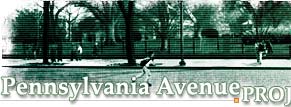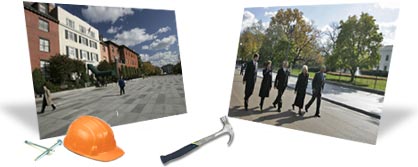
- Afghanistan
- Africa
- Budget Management
- Defense
- Economy
- Education
- Energy
- Environment
- Global Diplomacy
- Health Care
- Homeland Security
- Immigration
- International Trade
- Iraq
- Judicial Nominations
- Middle East
- National Security
- Veterans
- President's Cabinet
- USA Freedom Corps
- Faith-Based & Community Initiatives
- Office of Management and Budget
- National Security Council
- USA.gov
 |
 |
|
Last update: November 10, 2004
The following information is from "Pennsylvania Avenue at the White House," a reopening ceremony pamphlet by the National Capital Planning Commission (November 2004).
A dignified new civic space featuring pedestrian-friendly amenities and site furnishings now graces the famous stretch of Pennsylvania Avenue in front of the White House. The redesign of America's Main Street has transformed the Avenue from one cluttered with ad-hoc security measures to a beautiful civic area befitting one of the nation's most prominent and visited destinations. The project is the result of the work of dozens of federal, local, and civic agencies that worked with the National Capital Planning Commission (NCPC), as well as the Federal Highway Administration (FHWA), which managed construction of the project. Thanks to the leadership and guidance of First Lady Laura Bush, the vision of an Avenue for the People is now a reality.
Ad-hoc security barriers first appeared on Pennsylvania Avenue after security concerns forced its closure in the wake of the 1995 Oklahoma City bombing. After the terrorist attacks of September 11, the number of barriers cluttering the historic Avenue soon proved to be overwhelming. Disheartened by the appearance of America's Main Street, NCPC in 2001 proposed the redesign of the Avenue, and in 2002 selected Michael Van Valkenburgh Associates to create a safe and beautiful pedestrian space on the Avenue. In September 2003, NCPC gave formal approval to the Van Valkenburgh design, and First Lady Laura Bush endorsed the project just days later during a White House ceremony. Throughout the project, Mrs. Bush strongly supported the effort, engaging in the design and the selection of materials to be used on the Avenue. Her steadfast support enabled the NCPC and the FHWA to transform the Avenue into a dignified civic space appropriate for a place of national significance. The FHWA began construction on the site in January 2004. Working on an expedited schedule, the agency completed a design that is both elegant and secure - a public streetscape for all Americans and our nation's visitors to enjoy.
The central elements of Van Valkenburgh's design include new paving materials; pedestrian amenities and site furnishings; a combination of retractable, removable, and fixed bollards; new guard booths; new trees; and a route for a planned transit system. The plan is simple and flexible and can be easily retrofitted to accommodate a vehicular thoroughfare in the future, should the security environment change.
To help unify Lafayette Park with the White House grounds, a more natural looking paving material was installed for the central portion of Pennsylvania Avenue and Jackson and Madison Places. At 15th and 17th Streets, large granite pavers that are a subtle mix of grays and pinks accentuate entry to the precinct and reinforce the connection of the Avenue to the city's urban fabric.
Pedestrian amenities are an important component of the project and contribute to the quality of the civic spaces. Forty-seven twin headed streetlights, originally designed by Henry Bacon in 1923, replaced the existing streetlights in the precinct. Sixteen new granite benches placed along the open walkways on the south side of the Avenue within the double tree row make welcome spots for visitors to sit and enjoy the historic scenery. In addition, the redesigned Avenue can accommodate the new Downtown Circulator, a hop-on, hop-off shuttle service that will provide convenient transportation to the city's national treasures.
In place of jersey barriers, the project employs specially designed bollards, some of which are retractable and removable. The retractable bollards will allow authorized vehicles to access the site while the removable bollards will accommodate the Inaugural Parade every four years. The bollards allow for free pedestrian movement, maintain a visually open environment, and respect the character of the street. The project's design also features elegant security booths that reflect the classical architecture found along the Avenue. The booths are placed at each entry point and when finished in November will have a granite base and lead-coated copper roof with cast iron columns painted to match the light fixtures.
In spring 2005 when planting conditions are favorable, 88 mature Princeton American Elms will be planted along the Avenue. The trees will stand where concrete bollards once lined the front of the White House. The American Elm has a high arching form that will provide a spectacular promenade as well as wonderful fall color and an attractive winter form. The new trees will provide a welcome canopy for pedestrians and a gracious setting for the White House grounds. The planting scheme will consist of a single row of street trees along the north and south curbs of Pennsylvania Avenue and a double row of trees along the south curb of the Avenue in front of the Eisenhower Executive Office Building and the Treasury Building. |
|









